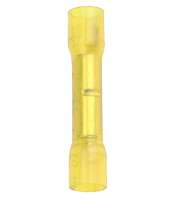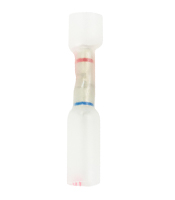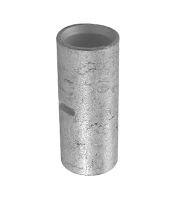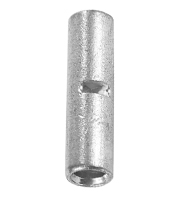Categories
- Wire & Cable
- Multi-conductor & Signal Cable
- Battery Cable Assemblies
- Terminals and Connectors
- Electrical Parts
- Electrical Tools
- ID Products
- Wire Management
- Tape & Sealant
- Mounting Panels & Panel Blanks

Need Help?
Click HereGet a Business Account
Apply HereButt Splices
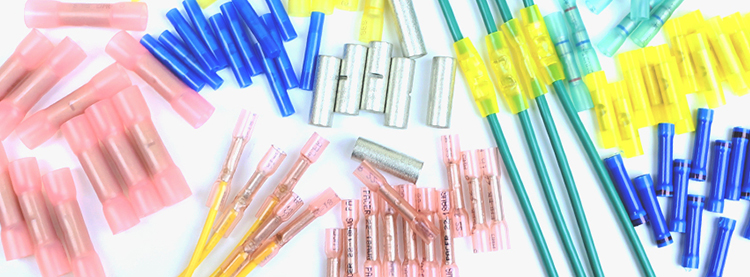
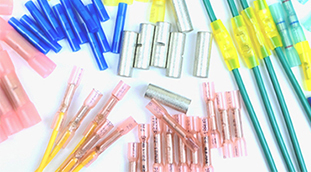
What are butt splices?
Butt splices are one of many types of crimp connectors used to safely connect one or more wires to another wire. It depends on which style of butt splice you are using and the task at hand. For example, step-down butt splices are meant to connect a higher gauge wire to a lower gauge wire. They could also be used to connect two or more smaller gauge wires to a single wire. Crimp connectors and other electrical connectors ensure quality connections. Their ease of use and economical pricing makes them very common in electrical systems. We will discuss the various types of butt splices further down the page.
"Their ease of use and economical pricing makes them very common in electrical systems."
When selecting which type of butt splice to get, pay special attention as to whether they are epoxy lined or not. Why is this important? Many manufacturers do not line the interior of their butt splices with a melt-able glue. This glue, or epoxy, reacts to heat and expands creating an environmentally sealed connection. This is useful in marine conditions or other environments where hazards may be present. To properly activate the epoxy, heat the ends of the butt splice with the proper tool after crimping. Epoxy lined is only available with heat shrink butt splices. The alternative to epoxy lined is either vinyl, nylon, or non-insulated. These types are useful in situations where the environment is not as much of a direct concern. Pacer's large inventory of butt splices are offered in heat shrink, nylon, vinyl, and non-insulated. In order to select the correct type of connector for your task, it is important to know what advantages that they offer.
Where are butt splices implemented?
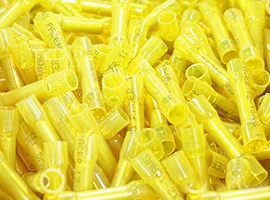
Butt Splices offer advantages over other terminals
Butt splices are implemented in connecting multiple wires together in order to complete an electrical circuit. Even though they are ideal for new wire and cable installations, butt splices are equally useful for replacing older parts or performing maintenance. How do you know if your existing butt splices need to be replaced? Are your butt splices faded? Are your butt splices cracked? If so, then it may be time to replace those splices with new ones. All you will need are the proper tools. Now let us take a look at what makes these types of connectors advantageous.
How is a butt splice advantageous?
Butt splices are advantageous as they allow you to connect two or more wires in a way that offers various protections to the connection point. These electrical connector types are built for longevity They are inherently durable which means that they can protect the connection point from impact and abrasion. If we are talking about an epoxy lined heat shrink butt splice, then you can add protection from moisture, chemicals, and stress to that list. As you can see, the advantages of these connectors are numerous which explains why they are such a common type of connector. One question we often get from our customers is how to use them.

Impact Resistance

Abrasion Resistance

Moisture Resistance

Chemical Resistance

Stress Relief
How do you use a butt splice?
Butt splices are used by crimping them to create a long-lasting durable bond. The first step is to select the correct size wire connectors and style for the task at hand. Next, you will want to strip your wires so that the bare conductors touch the indentation you will see inside of the butt splice barrel. The insulation should butt up to the outside of the barrel body. Now that your wires are properly stripped to the correct length and one side has been inserted, you will want to crimp that side of the butt splice with the proper tool. Now you should perform a gentle tug test to ensure that the wire does not pull free. To perform this test, simply hold onto the wire in one hand and the butt splice in the other. Apply gently pressure pulling the two pieces apart. If you feel any give, then you have not properly crimped the connector. This is important as if the wire pulls free at any point, you will lose connectivity and possibly create a hazardous situation. Once you have one side of the butt splice properly crimped, simply repeat the process on the other side of the connector body. One thing that makes this a simple task is using the right tools.

What types of Insulation are available for butt splices?
Buttsplices are available in a range of insulation types so that you can find the exact style you need. Ideal for use with marine wire, Pacer offers non-insulated butt splices, nylon butt splices, vinyl butt splices, and heat shrink butt splices. It is important to note that when dealing with marine applications you should only use marine grade butt splices. Without marine grade butt splices, you leave your electrical connections vulnerable to the harsh marine environment. All Pacer butt splices are marine grade butt splices making them ideal for any marine application. Electrical wire connectors need to handle the harshest environments.

So where might you use the different types of insulation? Let us look at heat shrink since it offers the most protection out of the four insulation types. Heat shrink marine grade butt splices are ideal when you need the highest level of protection possible. Heat shrink butt splices are the most durable option and the only option to create an environmental seal. Why is an environmental seal important? It blocks out moisture, dust, and other contaminants. Next up we have nylon. Nylon butt splices offer the next highest level of protection and offer translucent insulation meaning that crimp inspection is a simple task. When using nylon butt splices you can quickly and easily tell if you have connected the butt splice to your marine wire. Vinyl is the next type of insulation we will look at. Vinyl is the best choice when moisture, oil, and other contaminants are not a concern but you still want a decent level of protection. Vinyl butt splices do not have translucent insulation meaning that you must be more careful when crimping onto marine wire. The last type we will look at is non-insulated. These are the most economical option and are not a bad choice however, they offer little in the way of protection. These are commonly used in sealed enclosures or other areas that are isolated from exposure. Remember, regardless of the application, you always want to use marine grade butt splices on your boat. Otherwise, you leave your marine wire, and entire electrical system vulnerable. Now that we have covered different types of insulation, let us look at which tools you should consider.
Does the insulation on my butt splice matter?
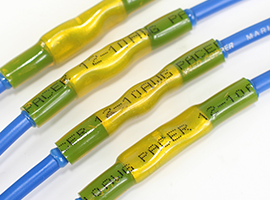
Yes, the insulation really matters. The insulation determines the amount of protection that the connection point is going to have. So, if you use a vinyl insulated butt splice you will not get the same level of protection that you would with a heat shrink butt splice. Choosing the right insulation really boils down to the application. We would personally advise you to always use heat shrink butt splices since they offer the highest level of protection you can possibly get on a butt splice. With that said, using nylon, vinyl, or even non-insulated butt splices is perfectly acceptable given the right circumstances. If you are planning to use butt splices in a location where moisture may be present, please ere on the side of caution and use the appropriate splices.
Why does epoxy lined heat shrink matter for my application?
Epoxy lined heat shrink matters for multiple reasons most important of which, is protection. When heat shrink has an epoxy lining, it creates a durable seal that blocks out moisture, oil, salt, and other hazards. Without that epoxy lining the heat shrink would not be as effective in blocking those hazards. More than that, using heat shrink with epoxy lining can help to reduce stress around the connection point and serves to protect against minor abrasion and impact. Overall, if you’re using heat shrink, use epoxy lined heat shrink especially in a marine environment.
What tools should I use with a butt splice?
Butt splices are designed to be crimped with specific tools. Wire connectors and other crimp connectors always need the proper tools. Determining the correct tool can be as easy as looking at the wire gauge. However, this is not always the case. The most versatile tool for butt splices is out VTTR50. This tool can pretty much handle every butt splice we carry as well as fork terminals, rings, disconnects, and more. Another versatile tool that will work on a multitude of terminals is our VT3120CT. Additionally, we carry a range of crimpers that can work with a variety of butt splices as well as other terminals.
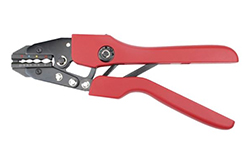
VTTR50
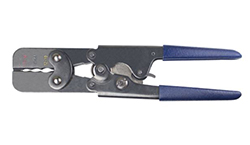
VT3120CT
What types of butt splices are available?
Butt splices are not a one-size-fits-all type of terminal, and as such, we carry a range of styles and types. Let’s take a quick look at some of the more common types of these connectors that we carry. Remember, one of the most important aspects of selecting the correct type is selecting an insulation that offers the protections you want. To learn more about the various types of insulation, click here.
Heat shrink Heat shrink butt splices offer the highest level of protection possible. That is due to the epoxy lining that we mentioned earlier. This lining creates an environmental seal that locks out moisture and helps to prevent corrosion. Heat shrink butt splices also offer stress relief on the wire itself and will arguably last the longest when considering other types of insulation. This is what makes these the most type of butt splice that you will find. They can literally handle nearly any environment
Step-down Step down butt splices are designed with a different internal diameter on each side of the connector body. This is so you can connect a larger size wire to a smaller wire. You can even connect multiple wires together. So, you could connect two smaller wires to two even smaller wires. A good example would be the TBSD14-18. This terminal is designed for a 14 AWG wire on one side and an 18 AWG wire on the other. You could, however, put two 16 AWG wires on one side and two 20 AWG wires on the other. This is what makes these butt splices so useful.
Seamless barrel Seamless barrel butt splices are essentially the same as the heat shrink butt splices just without the heat shrink. They offer a high degree of protection and can be installed in seconds. Seamless barrel splices get their name from the fact that they have no seam. This means that they can keep out dust and other particulates. One useful aspect of seamless barrel butt splices is that they are available in nylon insulation, vinyl insulation, or non-insulated. Our seamless barrel butt splices are available in 22-18 AWG, 16-14 AWG, and 12-10 AWG.
Seamless tinned Seamless tinned butt splices are extremely similar to the seamless barrel butt splices that we mentioned above. The biggest difference with these connectors is the wire sizes that they work with. Whereas a seamless barrel butt splice works with 22 AWG – 10 AWG wires, a seamless tinned butt splice will work with 8 AWG to 4/0 AWG. We offer them in 8 AWG, 6 AWG, 4 AWG, 2 AWG, 1/0 AWG, 2/0 AWG, and 4/0 AWG. Another important difference is that these connectors are only available in non-insulated.
How are butt splices different from other connectors?
Splices are different from other connectors in several ways including permanence of connection and method of installation. Whereas some connectors such as disconnects or ring terminals create semi-permanent connections that can be altered or undone, a butt splice creates a permanent connection point that cannot be separated. This is ideal for connection points that are in hazardous conditions and need the highest level of protection or are in situations where they will not need to be disconnected. A butt splice can also be installed in the middle of a wire rather than only on the end. This offers the advantage of allowing someone the ability to add a butt splice to create a branching path or even correct a mistake or repair a damaged section.

Why choose Pacer?
Pacer has been around for over forty years and has used that time to build a reputation as an industry leader. As a manufacturer for some of the world’s largest boat builders, we have set our focus on quality and customer service. This is why people come back to us time and time again. This is why we serve the entire chain, from the original equipment manufacturers to the everyday boater. We don’t just offer products, we offer solutions.
What industries use butt splices?
Buttsplices are a ubiquitous connector type and can be found in just about any industry that deals with electrical connections. Seriously, they really are that useful. Just a few of the industries that use butt splices include automotive, marine, power management, solar, data transmission, aerospace, communication, industrial equipment, the list goes on. As you can see, they are just about everywhere you could imagine and for good reason. They are simple to install and built for longevity.
![]()
![]()
![]()
![]()
![]()
*This page was updated on 8/1/2022*



